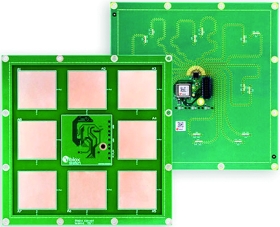

The ANT-B10 antenna board for Bluetooth direction finding and indoor positioning applications has been unveiled by u-blox. Designed for integration into commercial end-products, the board enables low-power, high-precision indoor positioning and speeds up evaluation, testing and commercialisation of applicable solutions.
Bluetooth indoor positioning uses the angle of arrival (AoA) of a Bluetooth direction finding signal emitted by a mobile tag at several fixed anchor points to calculate the tag’s location in real-time with sub-metre accuracy. The technology, which benefits from Bluetooth’s expansive ecosystem and interoperability across platforms, is gaining traction due to its low cost, high accuracy and relative ease of installation and maintenance.
Assembling an AoA indoor positioning anchor in seconds
ANT-B10 is a self-contained Bluetooth low energy antenna board featuring an antenna array comprising eight individual patch antennas and is built around a u-blox NINA-B411 Bluetooth 5.1 module. After processing incoming RF signals emitted by mobile tracker tags in the module’s radio and angle calculation processor, the solution outputs the calculated angle of arrival without requiring any additional processes.
The release also includes the XPLR-AOA-3 explorer kit. It features an application board, which offers developers a quick and easy way to evaluate and test the ANT-B10 antenna board, as well as u-blox’ direction finding algorithm. An off-the-shelf pin header on the application board allows for easy bring-up and testing of ANT-B10 and third-party antenna boards and connecting the two boards yields a ready-to-use AoA indoor positioning anchor point in seconds.
Ready to go for end-product integration
ANT-B10 and XPLR-AOA-3 complement the existing u-blox indoor positioning offering, which includes the popular XPLR-AOA-1 and XPLR-AOA-2 kits. Using u-connectLocate, which runs on ANT-B10’s Bluetooth module, solution developers can easily execute the angle calculation algorithms using AT commands. When combined, the solution suite is ready to go for end-product integration.
Common use cases for Bluetooth indoor positioning and direction finding include tracking assets in industrial settings such as warehouses, as well as people and things in hospitals, retail environments or museums. Additionally, access control systems deployed in connected buildings can use angle detection to determine which side of a door users are located on.
Actively engaged with the technological ecosystem
To determine the angle of arrival of incoming signals for direction finding, the ANT-B10 board concurrently processes them on all eight patch antennas. Because implementing multiple RF paths connected to multiple RF switches unnecessarily increases power demand and introduces errors, the ANT-B10 board uses an industry-leading single RF switch component from u-blox’ partner, CoreHW, that cycles through the eight antennas at a microsecond timescale.
| Tel: | +27 21 555 8400 |
| Email: | [email protected] |
| www: | www.rfdesign.co.za |
| Articles: | More information and articles about RF Design |
© Technews Publishing (Pty) Ltd | All Rights Reserved